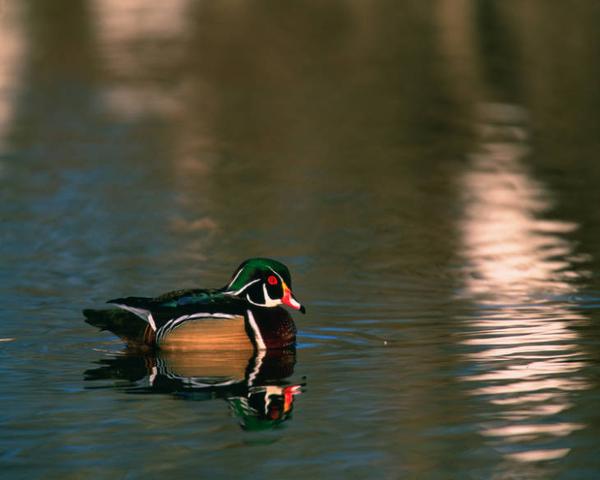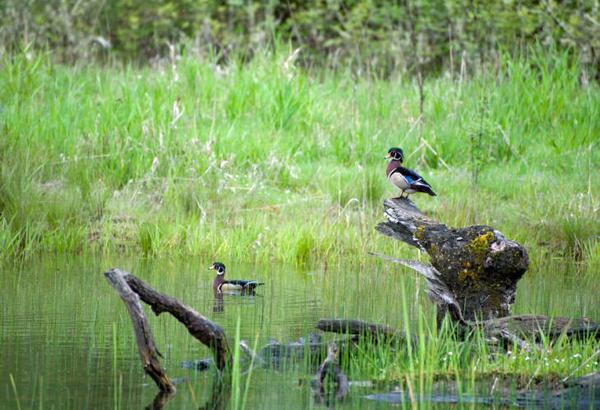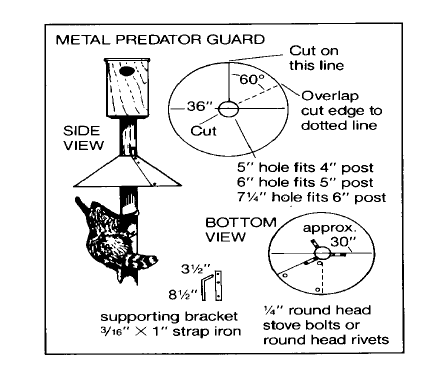Habitat Requirements
Wood ducks depend upon wetlands, including streamside forest, forested wetlands, and freshwater marshes, for food and cover. Wood ducks nest in cavities, including those in live and dead trees or in nest boxes placed around margins of wetlands. Habitat must include nesting cavities and the appropriate food as described below. Additionally, wetlands with emergent vegetation for overhead protection from predators and slow moving or still water are important for wood duck broods. Flooded forest with cypress and gum are premium for roosting. Also, many beaver ponds provide high quality wood duck habitat.
Food
The diet of the wood duck includes hard and soft mast, insects, other aquatic invertebrates (mollusks, snails), and aquatic plants and seeds. Mast is the fruit of trees and shrubs, including acorns, nuts, and berries. Wood ducks feed in and around wetlands, as well as in uplands, sometimes considerable distances from open water.
|
Seasonal wood duck foods. |
||||
|
Spring |
Summer |
Fall |
Winter |
|
|
Acorns |
X |
X |
X |
|
|
Hickory nuts |
|
|
|
X |
|
American beech nuts |
|
|
X |
X |
|
Blackgum fruits |
X |
X |
||
|
Waterlily (Nymphaea) seeds |
X |
|
X |
X |
|
Blackberry fruits |
|
X |
|
|
|
Smartweed seeds |
|
X |
X |
|
|
Maple seedsAsh seedsElm seeds |
X |
X |
X |
|
|
Duckweed |
X |
X |
X |
X |
|
Pondweed |
X |
X |
X |
|
|
Invertebrates |
X |
X |
X |
X |
Cover
Nesting cover requires cavities or nest boxes, located between 6 and 30 feet above ground. Nesting cavities should be within 1⁄2 mile from water, although wood ducks have been known to nest up to 1 mile away from water. Mature trees of at least 16 inches in diameter are the primary source of cavities. When cavity trees are not available, wood ducks willingly nest in nest boxes. Maintain at least one cavity or box for every 5 acres of woodlands.
Wood ducks do not excavate their own cavity and instead use abandoned woodpecker cavities or other natural cavities. The entrance should be no larger than 4 inches and the cavity should be large enough to support an average of 11 young. Once successful, a female will nest in the same cavity year after year.
Once they hatch, ducklings leave the nest cavity immediately and seek out protective brood cover that harbors invertebrate foods. Brood cover is characterized by flooded emergent vegetation, including some shrubs and trees, in approximately 1:1 ratio of plant cover to open water.
Home Range
Due to the migratory and mobile nature of the wood duck, home range is difficult to define. The average feeding radius is 25 to 30 miles every day. Annual migrations reach hundreds of miles.
Because of the mobility and migratory habits of waterfowl, home range is not a consideration in habitat management except in terms of the brood-rearing and nesting requirements discussed above, and feeding radius.
Wood Duck Management
Improving Wood Duck Habitat
Mature hardwood
- Retain hardwood or mixed pine / hardwood types
- Keep 1⁄3 of tract in 50 year or older trees
- In pine types, create or retain hardwood patches (5 acres or more)
- Maintain a distribution of age classes, especially along water edges
Mast production
- Protect areas of mast production
- Release the crowns of mast trees so they will expand and increase mast production
Intermediate treatments
- Thin to promote development of tree crowns
- Favor leaving/releasing mast species during thinning operations
- Favor a mix of red oaks and white oaks
Direct improvements
- Retain all oaks adjacent to or overhanging wetlands
- Retain identified cavity trees within 1⁄2 mile of water
- Leave small areas of unharvested cropland near wetlands
- Temporarily flood hardwood stands or farm fields during winter months to attract ducks for hunting and overwintering (consult appropriate authorities before flooding land)
- When not threatening property damage, protect beaver ponds
- Erect nest boxes where cavity trees are lacking
Many game and nongame species with habitat requirements similar to wood ducks benefit from wood duck management. Management plans should emphasize the community of species that share wood duck habitat
| Mallard | Black duck | Pileated woodpecker |
| Hooded merganser | Belted kingfisher | Screech owl |
| Red-headed woodpecker | Prothonotary warbler | Yellow-rumped warbler |
| Swamp sparrow | Southern leopard frog | Red-bellied watersnake |
| Painted turtle | Muskrat | Beaver |
Working With Wildlife
North Carolina State University Extension - Forestry
Working With Wildlife Series
Publication date: May 1, 2019
Revised: May 30, 2019
N.C. Cooperative Extension prohibits discrimination and harassment regardless of age, color, disability, family and marital status, gender identity, national origin, political beliefs, race, religion, sex (including pregnancy), sexual orientation and veteran status.
N.C. Cooperative Extension prohibits discrimination and harassment regardless of age, color, disability, family and marital status, gender identity, national origin, political beliefs, race, religion, sex (including pregnancy), sexual orientation and veteran status.






